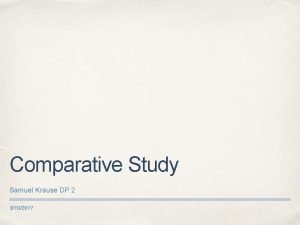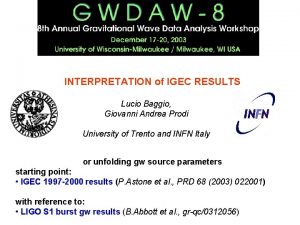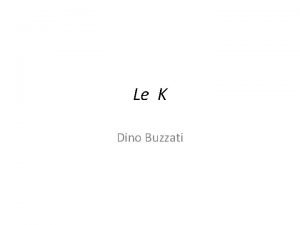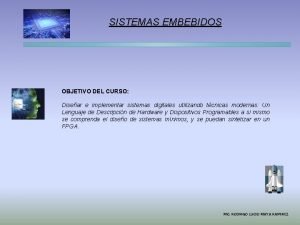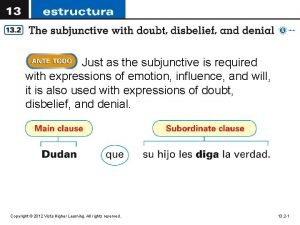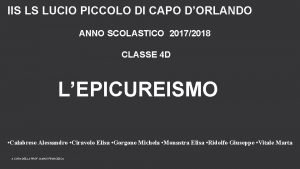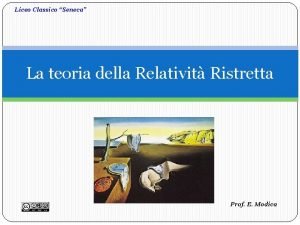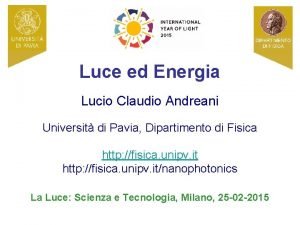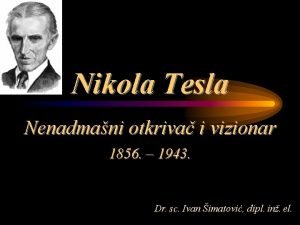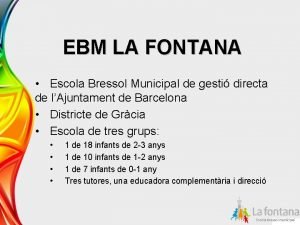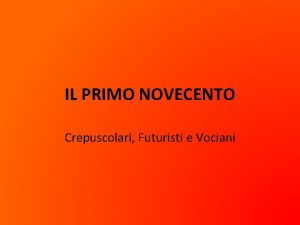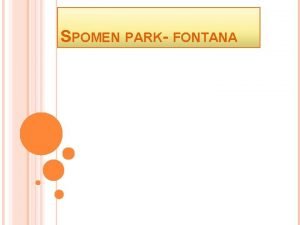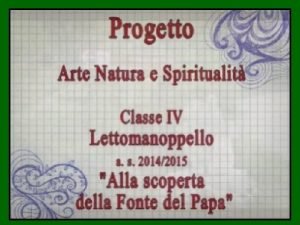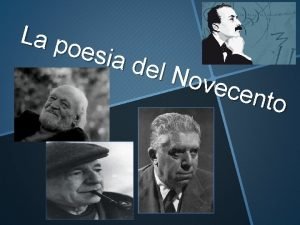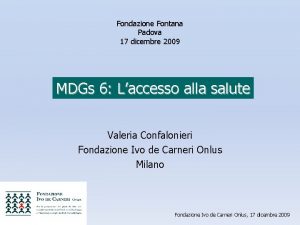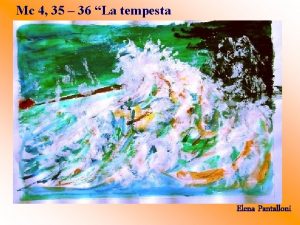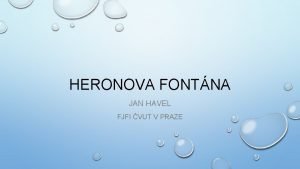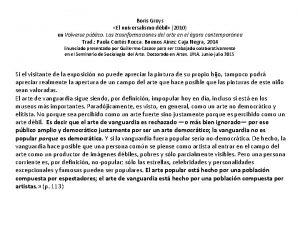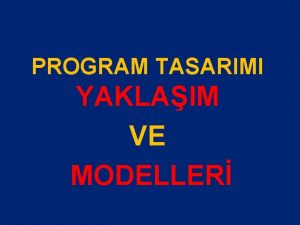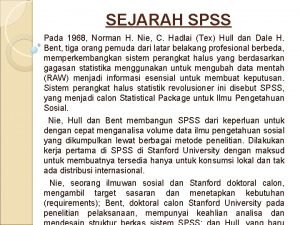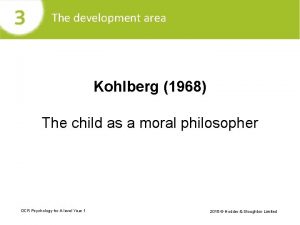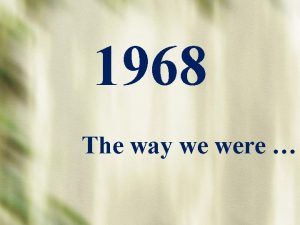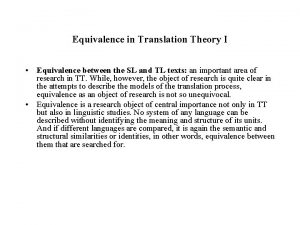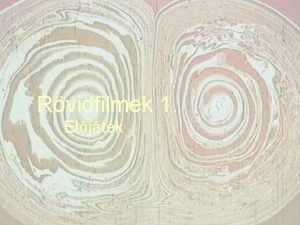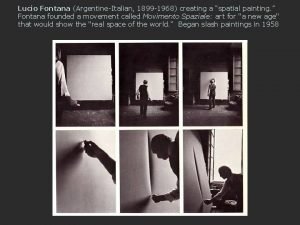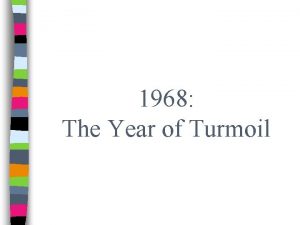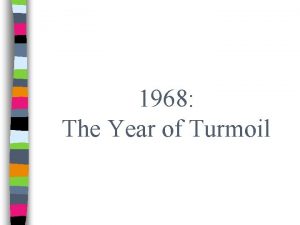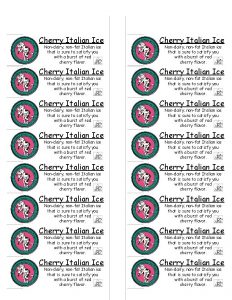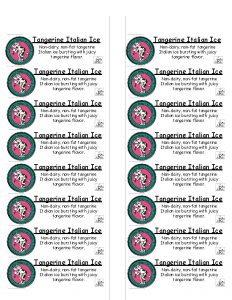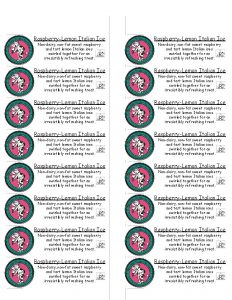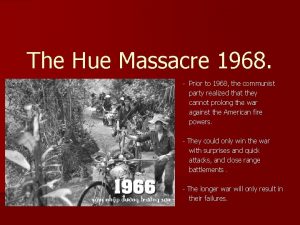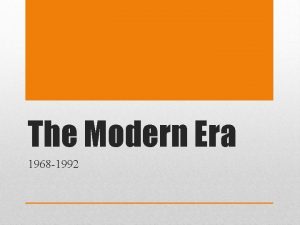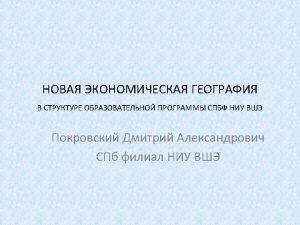Lucio Fontana Italian 1989 1968 Spatial Concept Expectations


















































- Slides: 50

Lucio Fontana, (Italian, 1989 -1968) Spatial Concept, Expectations, 1959 water-based paint on canvas, 49 5/8 x 98 3/4 inches

Cy Twombly (US, b. 1928) (left) Leda and the Swan, Rome (artist’s home since 1957) 1962, oil, pencil, and crayon on canvas, 6' 3" x 6' 6 3/4“ Mo. MA NYC (right) Untitled, Rome, 1960; oil, pencil and oil stick canvas palimpsests, graffiti, T. S. Eliot’s Wasteland: “fragments I have shorn against my ruin”

Helen Frankenthaler (American b. 1928), Mountains and Sea, 1952, oil on canvas, 7’ 2” x 9’ 9” COLOR FIELD / GREENBERGIAN FORMALISM (late “Modernist” painting)

Helen Frankenthaler in 1950 on seeing Pollock's paintings, Autumn Rhythm and Lavender Mist: It was as if I suddenly went to a foreign country and didn't know the language, but had read enough, and had a passionate interest, and was eager to live there. I wanted to live in this land. I had to live there, and master the language. " Photograph: Jackson Pollock (far left) with Lee Krasner (far right), Clement Greenberg, unidentified child, and Helen Frankenthaler at the beach / unidentified photographer, ca. 1952.

Frankenthaler, Magic Carpet, 1964, 96 X 68 inches, acrylic on canvas

Morris Louis (American, 1912 -1962), Tet, 1958, synthetic polymer on canvas, 8 x 13 ft

Jules Olitski (Ukrainian-born American, 1922 -2007) (right), Draky 1966, and (left) Comprehensive Dream, both are 120 x 92 inches, acrylic on canvas. Greenbergian Formalism – Color Field – Post-Painterly Abstraction

Kenneth Noland (American, b. 1924) Turnsole, 1961, Synthetic polymer paint on unprimed canvas, 7' 10 1/8" x 7' 10 1/8"

Josef Albers (Germany, 1888 - US, 1976) from series, Homage to the Square: (top right) Ascending 1953; and (lower right) Atuned, 1958, both are oil on masonite. Émigré Bauhaus master, influential teacher at Black Mountain College and Yale University Albers’ 1963 Interaction of Color, a pedagogical book still in print and much used http: //www. laurentianum. de/ldalbe 03. gif

Page from Albers’ Interaction of Color, Yale university pedagogical book.

Grace Hartigan (American, b. 1922), (left) Billboard, 1957, o/c; (right) Chinatown, 1956, o/c, 42 x 52”

(left, at table) Frank O’Hara, Larry Rivers, Grace Hartigan (and David Smith standing at far left) at the Five Spot, NYC 1957 (center) Larry Rivers (American 1923 -2002), Portrait of Frank O’Hara, 1954. o/c, 97"/ 53” (right) Larry Rivers, Jack Kerouac, David Amram, Allen Ginsberg, Gregory Corso “New York School” poets and Beat poets

Alex Katz, Ada (in Black Sweater), 1957, oil on masonite, 24 x 18 in

Alex Katz (US, b. 1927) Black and Brown Blouse, 1976 and installation view of 1987 exhibition

Philip Pearlstein (USA, b. 1927) Female Model on Eames Stool, 1978

Pearlstein, Female Model on Oriental Rug with Mirror, 1968

Lucian Freud, (British, b. Berlin 1922), Interior in Paddington, 1951, o/c, 60” x 45”

Freud, Girl With a White Dog, 1951 -52; o/c, 30 x 40”; Tate Gallery, London “I paint people, not because of what they are like, not exactly in spite of what they are like, but how they happen to be. ”

Freud, Naked Girl Asleep, 1968, o/c, 22 x 22 in (right) Man Posing, ink on paper, 1984

Freud, Reflection (Self-Portrait), 1985, Oil on canvas, 22 x 21 in (right) Sigmund Freud (grandfather)

Lucian Freud, Naked Man; Back View, 1992 -1992

Clyfford Still (US, 1904 -1980), 1951 (right) Mark Rothko, 1952 Instructors at the California School of Fine Art (now San Francisco Art Institute) in the late ‘forties Abstract Expressionist influence on Bay Area Figure painters: David Park, Elmer Bischoff, and Richard Diebenkorn

David Park (US, 1911 -1960) , (left) Seated Man in a T-Shirt, 1958, SFMo. MA (right) Art Nature & Civilization, 1934, WPA Mural, San Francisco, Hayes Valley (below right) Three Violinists and Dancers, 1935 -37 Bay Area Figurative Expressionism and Social Realism

David Park, Torso (detail, right) 1959, SFMo. Ma "David was keen about Abstract Expressionism as long as it had the immediacy and tangibility and goopy sensuous arrangement of forms, but when it got into the very serious 'views of the cosmos' he didn't go along with that. " (Elmer Bischoff)

Richard Diebenkorn, (US, 1922 -1993) , Coffee, 1958, o/c (right) Woman in Profile, 1958, o/c Bay Area Figuration

Richard Diebenkorn, Ocean Park No. 54, 1972; (right) Berkeley #23, 1955 Both oil on canvas, Collection SFMOMA

Elmer Bischoff (US, 1916 -1991), Two Figures on the Seashore, 1957, o/c (right) Orange Sweater, 1955

Joan Brown (US, 1938 -1990), Bay Area Figuration, student of Elmer Bischoff (left) Wolf in Studio, enamel on masonite, 90 x 48”, 1972 (Crocker collection) (right) Self With Fish, 1970

Bay Area Funk (Beat) and Figuration overlapped. Joan Brown was part of both movements. Fur Rat, 1962, wood, chicken wire, plaster, string, raccoon fur, and nails; 20 x 54 x 14 in. University of California, Berkeley Art Museum Brown c. 1960 Exhibition of works from the early 70’s including cardboard sculptures (begun in her kitchen from household materials while her studio was under renovation)

Wayne Thiebaud (US, b. 1920), Five Hot Dogs, 1961, o/c, 18 x 24 in, Whitney MAA

Thiebaud, Cakes, 1963

Thiebaud, (left) Down Eighteenth Street, oil/charcoal/canvas, 1980, 45 x 36 in, Hirshorn (right top) Y River, 1998, o/c, 72 x 72 in compare Diebenkorn, 1955

Jiro Yoshihara (Japan 1905 – 1972), Painting, 1960 founded Gutai Bijutsu Kyokai (Concrete Art Association) in Osaka in 1954 When Jiro Yoshihara died in 1972 the Gutai Art Association was dissolved

Shozo Shimamoto (Japan 1928), Holes, 1954 (right) Painting, 1955 (slashed, punctured, like Fontana) Gutai

Atsuko Tanaka (Japan, 1932 -2005), Electric Dress [as performance (left) and display as object (right)] 1956, Gutai Blinking incandescent lights covered with red, blue, yellow, and green enamel paint. Flashing on a circuit, the shapes and colors of the figure wearing the costume changed constantly, giving the impression of a body in constant motion even when standing still. “I was seated on a bench at the Osaka station, and I saw a billboard featuring a pharmaceutical advertisement, brightly illuminated by neon lights. This was it! I would make a neon dress!” - Tanaka

Atsuko Tanaka, Drawing after "Electric Dress, " 1956, ink, crayon, and watercolor on paper, 109 x 77 cm, 21 st Century Museum of Contemporary Art, Kanazawa

Saburo Murakami, Gutai perfomance: Smashing Through (21 panels of 42 papers) second Gutai exhibition, Tokyo, 1956 Performance art, like almost all innovations in modern & post-modern art history, came out of painting and was the invention of painters. Painting is the “Ur-medium. ”

Kazuo Shiraga (Japan b. 1925), Challenge to the Mud, Gutai performance, 1955 Art as a marriage of concept and raw material: the Gutai notion of allowing the “cry of the material”

Shiraga, Second Gutai exhibition, 1956, “action” painting (verb) with feet; (center below) Painting (object) (right) Gutai exhibition of Siraga’s paintings (objects) made with feet

Allan Kaprow (US, 1927 -2006), 18 Happenings in 6 Parts, Reuben Gallery, NYC, 1959 Art News, October 1958, published Allan Kaprow’s article, "The Legacy of Jackson Pollock, ” which was an analysis of Pollock's work and a meditation on the meaning of his death (1956) for the painting avant-garde.

Allan Kaprow, Yard, Martha Jackson Gallery, NYC 1961; compare (right) Pollock painting, 1950 Young artists of today need no longer say, "I am a painter" or "a poet" or "a dancer. " They are simply "artists. " All of life will be open to them. - Kaprow, “The Legacy of Jackson Pollock, ” 1958

John Cage (US, 1912 -1992) early 1950 s, prepared piano, aleatory (chance) music, Zen Buddism and the I Ching (Book of Changes) "In the nature of the use of chance operations is the belief that all answers answer all questions. “ Don’t try to change the world, you’ll only make it worse. -Cage

(left) Italian Futurist Music event, 1913, The music of chance and “noise, ” including the sounds of urban life; (right) Hugo Ball performing Dada poem at the Cabaret Voltaire in Zurich, Switzerland, 1916 New York Dada In Advance of a Broken Arm by Marcel Duchamp, 1915 Sources for Neo-Dada of the 1950 s Jean Arp, Collage Arranged According to the Laws of Chance, 1916. Dada

Marcel Duchamp (center) with Carolyn Jones and Merce Cunningham after a performance of Walk Around Time. Sound by John Cage, set (after Duchamp’s Large Glass) by Jasper Johns. Mid-1960 s Neo-Dada Rrose Sélavy by Man Ray, 1920

Robert Rauschenberg (US, b. 1925), seated on Untitled (Elemental Sculpture) with White Painting (seven panel) behind him in the basement of Stable Gallery, New York (1953). Paintings were used for the watershed Black Mountain Cage “Event” of 1952: the “first” Happening. John Cage wrote a statement for the White Paintings: ". . . No subject/ No Image/No taste/No object/No beauty/No message/ No talent/No technique. . . /No idea. . . “ For Cage, this was high praise. Radical anti-subjective and post-modern

Fred Mc. Darrah (US, b. 1926), Dillon's Bar, University Place: Frank O'Hara, Robert Rauschenberg, Merce Cunningham, John Cage, Jasper Johns, and Anna Moreska, Nov. 10 at Dillon's Bar, NYC, 1959 (right) Rauschenberg, Merce Cunningham, John Cage on tour with the Merce Cunningham dance company

Robert Rauschenberg and Carolyne Brown, Pelican, performance, Merce Cunningham dance company, 1963

Robert Rauschenberg, Bed, 1955, mixed media, Mo. MA, NYC Detail of bed: scatological treatment of paint (anti-aesthetic)

(left) Robert Rauschenberg, Erased de Kooning Drawing, 1955, SFMo. MA, Neo-Dada; (right) Willem de Kooning, Woman 1, oil on canvas, 1952, Mo. MA NYC, Abstract Expressionism. Art after Abstract Expressionism has been called “The Academy of the Erased De Kooning. ”

Rauschenberg, Monogram, 1955 - 59, Combine: oil and collage on canvas with objects.
 Oflinemaps
Oflinemaps Lucio costa brasilia plan
Lucio costa brasilia plan Lucio rossi
Lucio rossi Robert lucio
Robert lucio Lucio baggio
Lucio baggio Lucio predonzani
Lucio predonzani Piccolo lucio nutella
Piccolo lucio nutella Rodrigo lucio maya ramirez
Rodrigo lucio maya ramirez No es cierto que paco y daniel nos 1 of 1 (ayudar).
No es cierto que paco y daniel nos 1 of 1 (ayudar). Aeneadae sive decius
Aeneadae sive decius Marcos infrastructure
Marcos infrastructure Quadrifarmaco epicuro
Quadrifarmaco epicuro Liceo classico lucio anneo seneca
Liceo classico lucio anneo seneca Lucio rossi
Lucio rossi Lucio tarquinio
Lucio tarquinio Lucio andreani
Lucio andreani Colin milligan
Colin milligan Teslina fontana
Teslina fontana Heronova fontána
Heronova fontána Sabrina fontana
Sabrina fontana Ebm la fontana
Ebm la fontana Tri tri tri fru fru fru
Tri tri tri fru fru fru Spomen park knjazevac
Spomen park knjazevac Fontana vicino a me
Fontana vicino a me Disatrico
Disatrico Fontana mix john cage
Fontana mix john cage Andrea matteo fontana
Andrea matteo fontana Sei quasi brutta
Sei quasi brutta Fondazione fontana padova
Fondazione fontana padova Fontana ros
Fontana ros M
M La fontana malata disegno
La fontana malata disegno Heronova fontána
Heronova fontána Tc 24 juin 1968 société distilleries bretonnes
Tc 24 juin 1968 société distilleries bretonnes Richard serra splashing 1968
Richard serra splashing 1968 Club of rome schulen deutschland
Club of rome schulen deutschland 1966 1967 1968 1969 1970 1971 1972 1973 1974 1975
1966 1967 1968 1969 1970 1971 1972 1973 1974 1975 Spaulding 1968
Spaulding 1968 Program tasarım yaklaşımları
Program tasarım yaklaşımları Spss 1968
Spss 1968 Discipline and appeal rules 1968
Discipline and appeal rules 1968 Orne and holland 1968
Orne and holland 1968 Kohlberg 1968
Kohlberg 1968 Mai lai massacre
Mai lai massacre Der große knall bitterfeld 1968
Der große knall bitterfeld 1968 1968 cost of living
1968 cost of living Introduccion del movimiento estudiantil de 1968
Introduccion del movimiento estudiantil de 1968 Edwin locke goal setting theory 1968
Edwin locke goal setting theory 1968 Equivalence examples in translation
Equivalence examples in translation 1968 hayat bilgisi programı
1968 hayat bilgisi programı Mélyvíz 1970
Mélyvíz 1970

